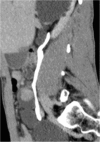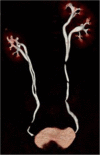Ureteral tumor in an ectopic duplex system: a case report
- PMID: 30845986
- PMCID: PMC6407215
- DOI: 10.1186/s13256-019-1974-2
Ureteral tumor in an ectopic duplex system: a case report
Abstract
Introduction: Ureteral ectopia is a rarely observed anomaly. It may be totally asymptomatic. An association with a duplex system is exceptional. Diagnostic and therapeutic approaches are challenging. Carcinologic surgery must consider the anatomic variant, mainly related to the ectopic site of the ureteral orifice.
Observation: We report a case of a ureteral urothelial carcinoma in a North African 52-year-old male patient, in a right duplex system. Radiological explorations concluded a non-functional upper right kidney. A suspect mass was observed in the lumbar part of the ureter of the right upper system. The meatus of the tumorous ureter ended in the right lobe of the prostate. A right hemi-nephro-ureterectomy was performed. A histological examination concluded a pT2G2 urothelial carcinoma.
Conclusion: Even if malignancy is rarely observed in ureteral ectopia, it should be evoked mainly in cases of hematuria with risk factors for urothelial tumors.
Keywords: Nephroureterectomy; Ureter abnormalities; Ureteral neoplasms.
Conflict of interest statement
Ethics approval and consent to participate
No ethics committee approval is required at our institution for a case report involving a limited number of patients.
Consent for publication
Written informed consent was obtained from the patient for publication of this case report and any accompanying images. A copy of the written consent is available for review by the Editor-in-Chief of this journal.
Competing interests
The authors declare that they have no competing interests.
Publisher’s Note
Springer Nature remains neutral with regard to jurisdictional claims in published maps and institutional affiliations.
Figures




References
-
- Glassberg KI, Stephens FD, Lebowitz RL, et al. Renal dysgenesis and cystic disease of the kidney: a report of the Committee on Terminology, Nomenclature and Classification Section of Urology, American Academy of Pediatrics. J Urol. 1987;138:1085–1092. doi: 10.1016/S0022-5347(17)43510-5. - DOI - PubMed
-
- Bauer S, Perlmutter A, Retik A, et al. Anomalies of the upper urinary tract. In: Walsh P, Retik A, Stamey TA, et al., editors. Campbell’s urology. 6. Philadelphia: Saunders; 1992. pp. 1357–1442.
Publication types
MeSH terms
LinkOut - more resources
Full Text Sources
Medical

